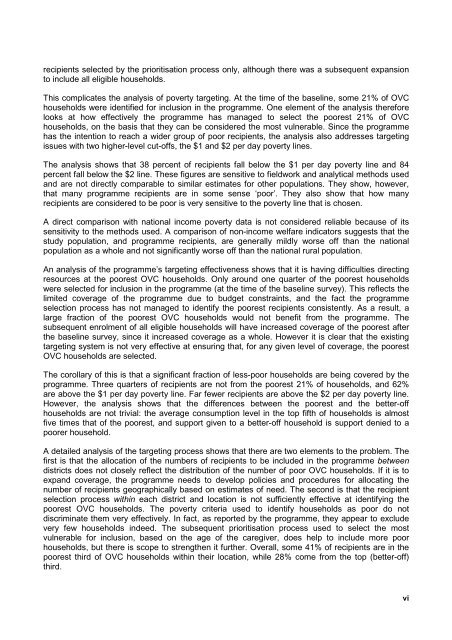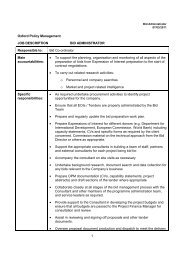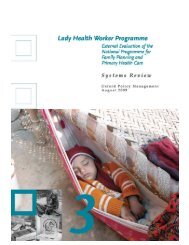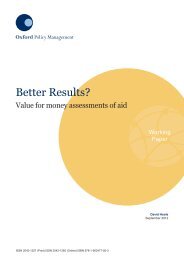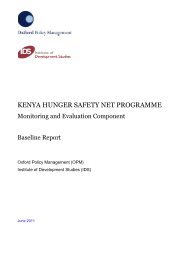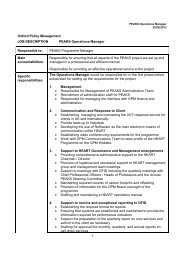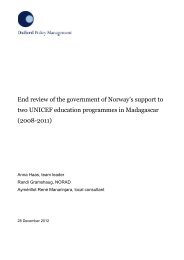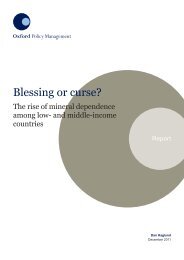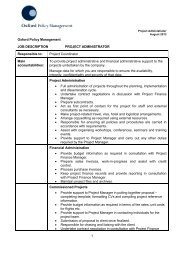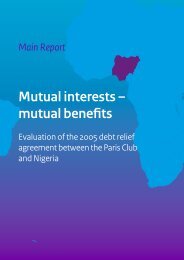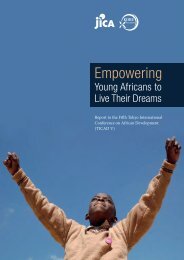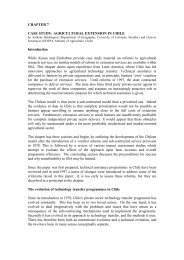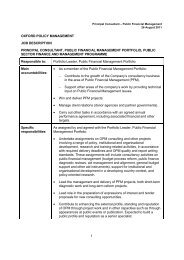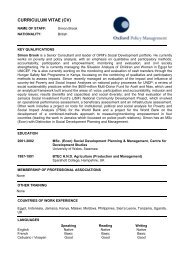Kenya OVC-CT Programme Operational and Impact Evaluation
Kenya OVC-CT Programme Operational and Impact Evaluation
Kenya OVC-CT Programme Operational and Impact Evaluation
Create successful ePaper yourself
Turn your PDF publications into a flip-book with our unique Google optimized e-Paper software.
ecipients selected by the prioritisation process only, although there was a subsequent expansionto include all eligible households.This complicates the analysis of poverty targeting. At the time of the baseline, some 21% of <strong>OVC</strong>households were identified for inclusion in the programme. One element of the analysis thereforelooks at how effectively the programme has managed to select the poorest 21% of <strong>OVC</strong>households, on the basis that they can be considered the most vulnerable. Since the programmehas the intention to reach a wider group of poor recipients, the analysis also addresses targetingissues with two higher-level cut-offs, the $1 <strong>and</strong> $2 per day poverty lines.The analysis shows that 38 percent of recipients fall below the $1 per day poverty line <strong>and</strong> 84percent fall below the $2 line. These figures are sensitive to fieldwork <strong>and</strong> analytical methods used<strong>and</strong> are not directly comparable to similar estimates for other populations. They show, however,that many programme recipients are in some sense ‘poor’. They also show that how manyrecipients are considered to be poor is very sensitive to the poverty line that is chosen.A direct comparison with national income poverty data is not considered reliable because of itssensitivity to the methods used. A comparison of non-income welfare indicators suggests that thestudy population, <strong>and</strong> programme recipients, are generally mildly worse off than the nationalpopulation as a whole <strong>and</strong> not significantly worse off than the national rural population.An analysis of the programme’s targeting effectiveness shows that it is having difficulties directingresources at the poorest <strong>OVC</strong> households. Only around one quarter of the poorest householdswere selected for inclusion in the programme (at the time of the baseline survey). This reflects thelimited coverage of the programme due to budget constraints, <strong>and</strong> the fact the programmeselection process has not managed to identify the poorest recipients consistently. As a result, alarge fraction of the poorest <strong>OVC</strong> households would not benefit from the programme. Thesubsequent enrolment of all eligible households will have increased coverage of the poorest afterthe baseline survey, since it increased coverage as a whole. However it is clear that the existingtargeting system is not very effective at ensuring that, for any given level of coverage, the poorest<strong>OVC</strong> households are selected.The corollary of this is that a significant fraction of less-poor households are being covered by theprogramme. Three quarters of recipients are not from the poorest 21% of households, <strong>and</strong> 62%are above the $1 per day poverty line. Far fewer recipients are above the $2 per day poverty line.However, the analysis shows that the differences between the poorest <strong>and</strong> the better-offhouseholds are not trivial: the average consumption level in the top fifth of households is almostfive times that of the poorest, <strong>and</strong> support given to a better-off household is support denied to apoorer household.A detailed analysis of the targeting process shows that there are two elements to the problem. Thefirst is that the allocation of the numbers of recipients to be included in the programme betweendistricts does not closely reflect the distribution of the number of poor <strong>OVC</strong> households. If it is toexp<strong>and</strong> coverage, the programme needs to develop policies <strong>and</strong> procedures for allocating thenumber of recipients geographically based on estimates of need. The second is that the recipientselection process within each district <strong>and</strong> location is not sufficiently effective at identifying thepoorest <strong>OVC</strong> households. The poverty criteria used to identify households as poor do notdiscriminate them very effectively. In fact, as reported by the programme, they appear to excludevery few households indeed. The subsequent prioritisation process used to select the mostvulnerable for inclusion, based on the age of the caregiver, does help to include more poorhouseholds, but there is scope to strengthen it further. Overall, some 41% of recipients are in thepoorest third of <strong>OVC</strong> households within their location, while 28% come from the top (better-off)third.vi


